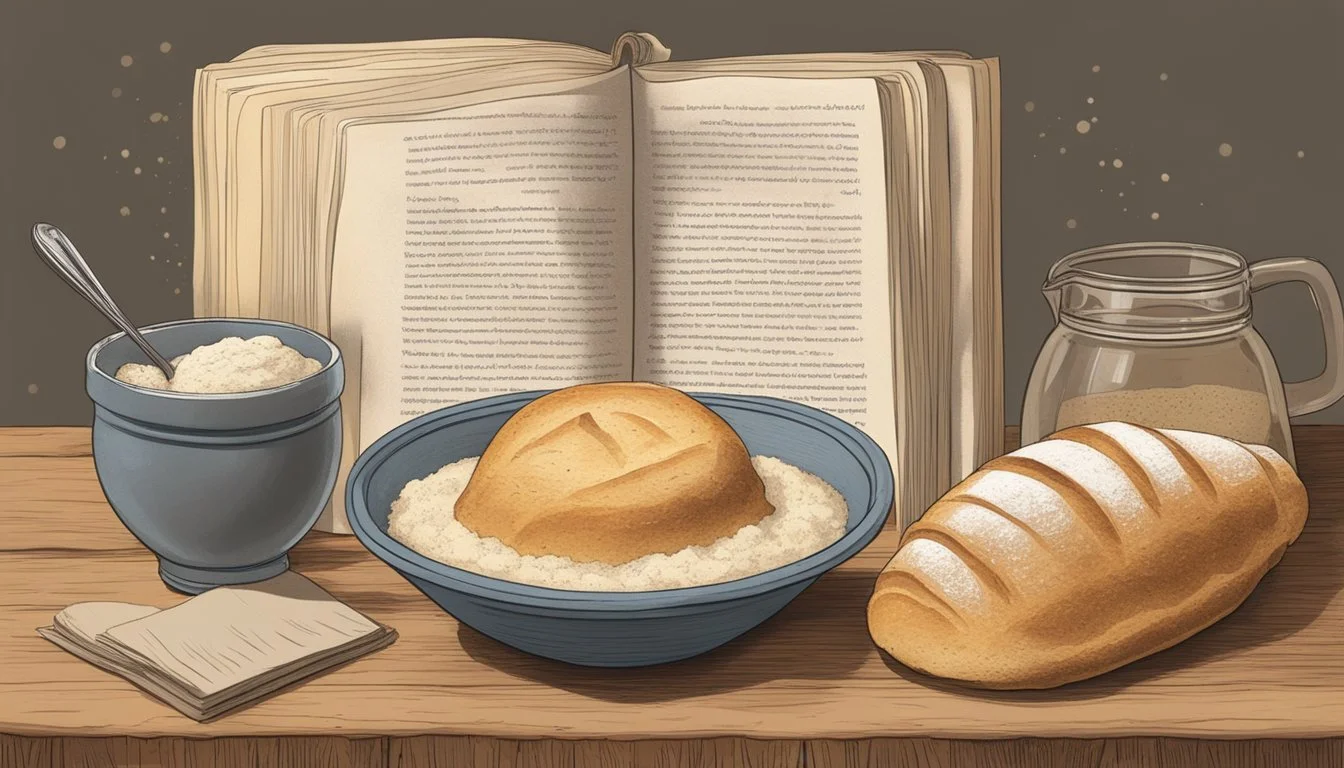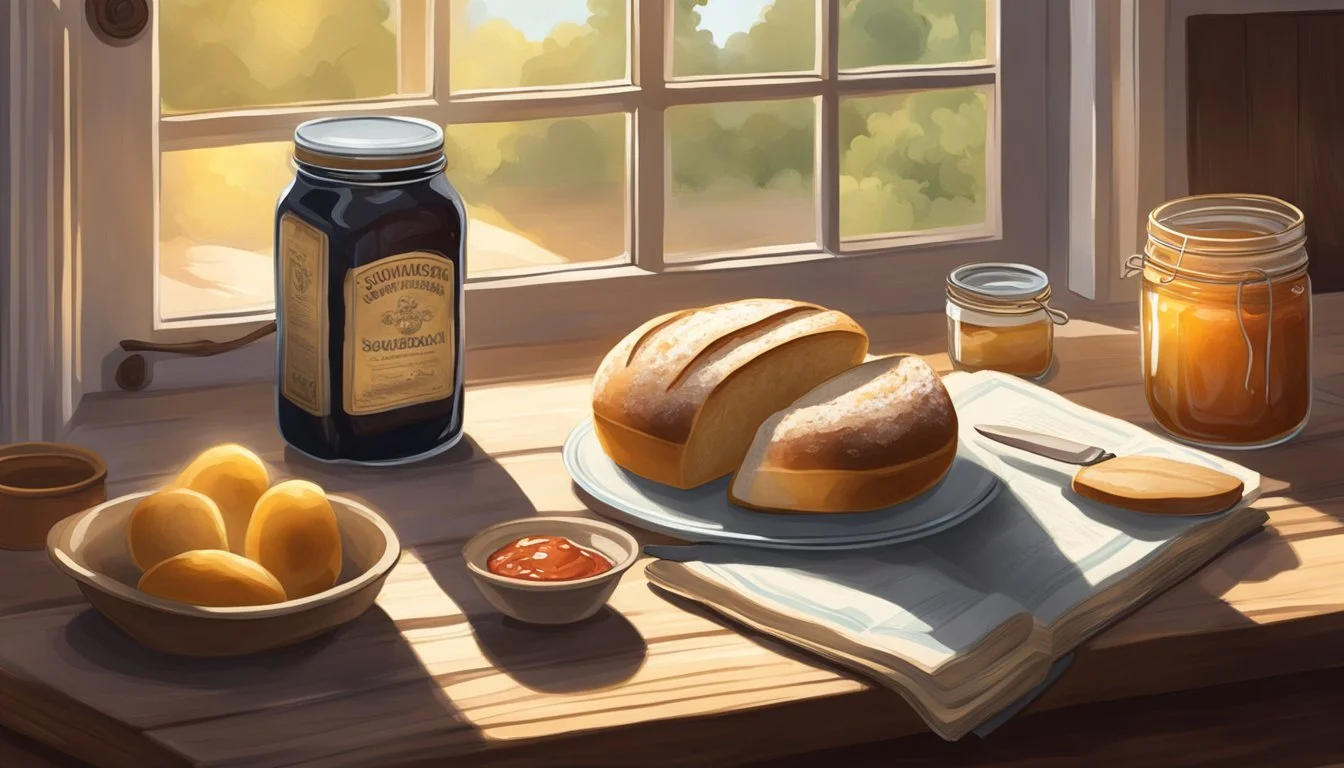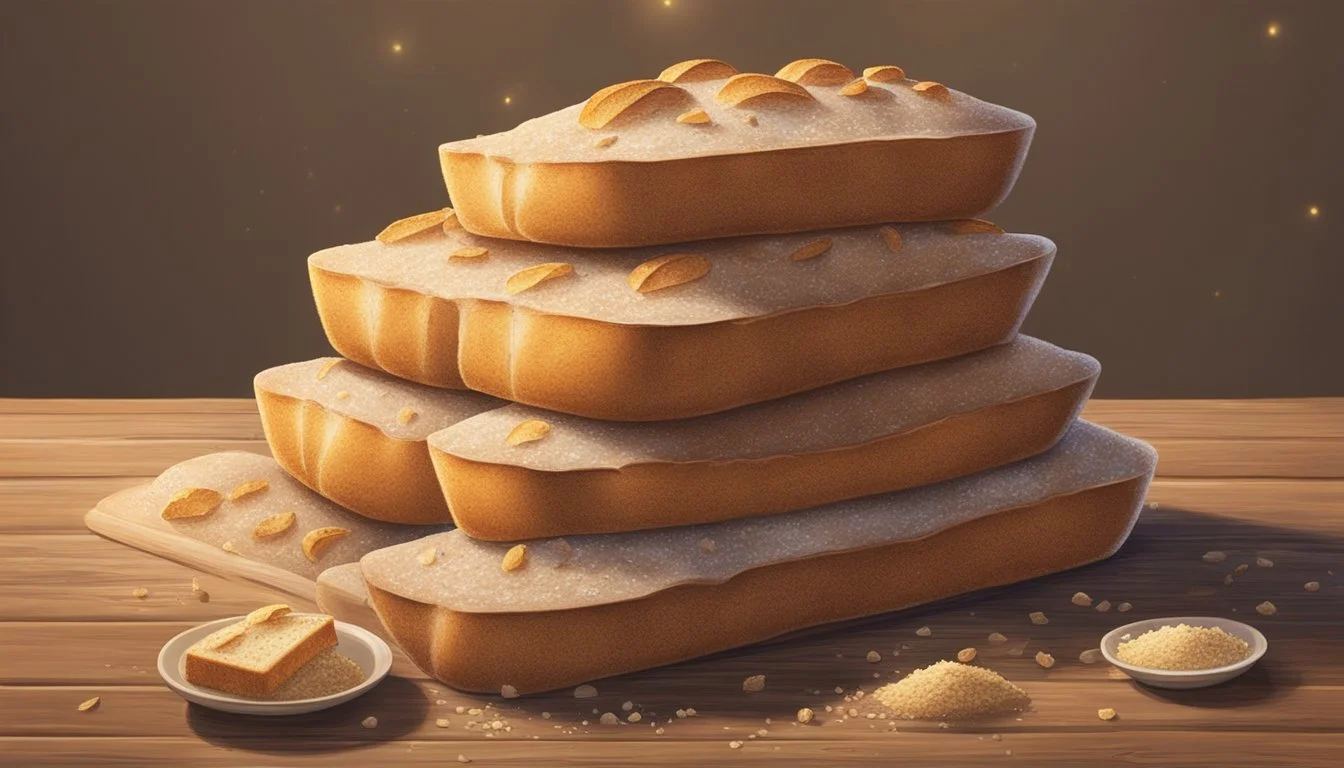Sourdough in Literature and Pop Culture
A Cultural Staple Explored
Sourdough, a term that often stirs images of crusty loaves and artisanal baking, has a presence that extends far beyond the kitchen. Steeped in tradition, sourdough bread (What wine goes well with bread?) is the product of a fermentation process that dates back centuries, and its cultural significance is as layered as its flavors. This bread-making technique has seen a resurgence in recent years, influencing not only food culture but also making a distinctive mark in literature and pop culture. The sourdough starter—a symbiotic culture of lactic acid bacteria and wild yeasts—serves as a potent symbol for resilience, sustainability, and the human connection to food.
As the world increasingly grapples with the concept of sustainability, sourdough has emerged as a protagonist in narratives that explore humanity's relationship with food and nature. In literature, characters are often shown nurturing their starters as a metaphor for growth and patience, mirroring real-life enthusiasts who find solace in the ritualistic aspects of sourdough baking. The intricacies of maintaining a starter's health and balance resonate with broader themes of care and connection in storytelling.
Pop culture, too, has recognized and celebrated the timeless appeal of sourdough. With the rise of home baking during global lockdowns, sourdough starters became symbolic of self-reliance and the small joys of life at a time when the world seemed unpredictable. From social media trends to feature articles, sourdough's humble mixture of flour and water fermented over time has been a testament to simplicity and creativity, impacting trends, reinforcing community bonds, and inspiring a renaissance of interest in traditional baking methods.
Historical Significance of Sourdough
Sourdough's role throughout history is marked by its durability as a staple and its cultural transfer between civilizations.
Sourdough Through the Ages
Sourdough has been a fundamental element in the history of food. It is documented that as early as 3000BC, sourdough bread's accidental discovery occurred in ancient Egypt. Artifacts and records point to the civilization's mastery of the fermentation process that gave birth to the first sourdough breads. What started as a happy accident transitioned into a critical skill, pivotal for survival and war times due to the bread's longer shelf life. As centuries passed, sourdough was not just a consumable item, it embodied a tradition that traversed through history, being part of daily life as well as ceremonial practices.
Sourdough in Various Civilizations
The technique of sourdough bread-making spread from Egypt and was adopted by various other civilizations, leaving a profound impact on their dietary customs. The Ancient Greeks and later the Roman Empire honed the sourdough process, passing down the art and science of this bread-making technique. In Gaul, present-day France, Greeks are credited with introducing sourdough in the fourth century BC, which integrated into the local culture and baking practices. Subsequent civilizations and modern cultures have continued to embrace and adapt sourdough methods, making it an enduring symbol of the evolution of civilization and gastronomy.
The Science of Sourdough
Sourdough bread-making intricately combines biology and chemistry within its artisanal craft. Through the natural fermentation process, an array of microorganisms such as yeast and bacteria work symbiotically to create a unique and complex starter ecology.
Fermentation and Microorganisms
Sourdough fermentation is essentially a biological process powered by microorganisms, particularly lactic acid bacteria and various strains of yeast. These microorganisms consume the carbohydrates present in the flour, producing carbon dioxide, alcohol, and organic acids as byproducts. One can observe a dynamic starter ecology where lactic acid bacteria are responsible for the tangy flavor of sourdough due to the production of lactic acid. The presence of these bacteria also helps in establishing an acidic environment, which is conducive to the growth of certain types of yeasts and inhibitory to others. This results in a distinct taste and texture for sourdough bread.
Key microorganisms involved in sourdough fermentation:
Saccharomyces cerevisiae: A common yeast in bread-making.
Lactobacillus: A genus of lactic acid bacteria that contributes to the acidity and flavor.
Chemistry of Sourdough
The chemistry of sourdough is a result of the metabolic activities of the fermentation microorganisms. During the fermentation, enzymes produced by these microorganisms break down the starches and proteins in the flour. For instance, amylase enzymes degrade starch into simpler sugars that yeasts can ferment, while proteases break down gluten proteins, affecting the dough's viscosity. The outcome is a complex mixture of fermentation metabolism byproducts, including:
Acids: Mainly lactic and acetic acids, giving sourdough its distinctive sour taste.
Alcohols: Ethanol is produced, which partially evaporates during baking.
Gasses: Carbon dioxide gas expansion is what leavens the bread, creating its porous structure.
The interplay between food chemistry and sourdough chemistry dictates the bread's final characteristics such as flavor, texture, and nutritional content. Moreover, a balance between acidity and leavening is crucial for the desired outcome, as the acidification process affects dough structure and can inhibit or encourage yeast activity.
Cultural and Social Impact
Sourdough bread-making extends beyond culinary practice to influence social connectivity and cultural traditions. It underscores the roles of community and human connection within civil society.
Sourdough in Community and Sharing
Sourdough has been a community staple historically, with its starter culture often being shared among neighbors and within families. This act of sharing not only disseminated the technique but also fostered a sense of cooperation and trust among members of a community, strengthening social ties. Community-driven sourdough practices reflect a larger tradition in civil society where recipes and methods are passed down, creating a collective cultural heritage. In social communities, the sharing of sourdough starter is symbolic, illustrating an unwritten social agreement of supporting one another through mutual exchange.
Sourdough and Human Connection
The practice of sourdough bread-making is a powerful medium for human connection. It transcends the simple act of baking to become a bond between people, embodying a shared cultural experience. Individuals often gather to discuss techniques, flavors, and the science behind the fermentation, which can lead to the establishment of bread clubs or informal forums that enhance community engagement. Furthermore, sourdough's global presence across various cultures emphasizes its role as a connector, bringing diverse groups together around a common passion for artisan bread-making, echoing the importance of tradition and culture in the formation of social bonds.
Sourdough Bread-making Techniques
Sourdough bread-making is a time-honored technique that revolves around the careful creation and maintenance of a starter and a meticulous baking process.
Creating and Maintaining a Starter
The starter is the foundation of sourdough bread-making. It's a fermented mixture of flour and water, which serves as a natural leavening agent.
Ingredients:
Flour: Whole grain flour often works best for starting a culture.
Water: Clean, non-chlorinated water is preferred to avoid killing the natural yeast.
Steps:
Mix equal parts flour and water in a clean container.
Cover with a breathable lid and let sit at room temperature.
Feed the starter daily with more flour and water to maintain its health and activity.
Maintenance:
Temperature: A warm environment, ideally between 70°F and 80°F, promotes yeast activity.
Feeding: Regular feeding maintains the starter's strength and fosters a stable population of yeast and bacteria.
Technology does not play a direct role in creating a starter, but tools like digital scales for measuring and temperature probes for monitoring conditions can enhance precision in starter maintenance.
Baking with Sourdough
Baking with sourdough involves patience and careful attention to the character of the dough.
Mixing:
Combine starter, water, and flour to form a dough.
Add salt to taste and additional water if necessary to achieve the right consistency.
Proofing:
Allow the dough to rise, a process potentially taking several hours.
It should be left in a consistent, warm environment, similar to that of sourdough starter maintenance.
Baking:
The dough should be baked until it achieves a golden-brown crust.
Artisanal techniques might include using a dutch oven or baking stone to create a steamy environment, mimicking commercial steam ovens.
Both artisanal and commercial bread-making have seen advancements due to technology. Mixers, proofing cabinets, and high-precision ovens can contribute to the consistency and quality of sourdough bread. Yet, many sourdough practices remain grounded in traditional techniques cherished by home bakers and professionals alike.
Sourdough in Literature and Media
Sourdough's resurgence during the pandemic has amplified its presence in literature and media, emphasizing the tradition and culture that surround it.
Portrayals of Sourdough in Books
In literature, sourdough bread often symbolizes tradition and the tactile experience of home baking. Robin Sloan's novel "Sourdough" exemplifies this, as it explores the story of a software engineer who inherits a sourdough starter that changes her life. Sloan's work is an ode to the intersection of food, technology, and culture. The novel delves into the fermentation process and the culinary art of sourdough bread making, reflecting how this ancient practice has found its way into contemporary storytelling and underlines the continued importance of sourdough as a cultural symbol.
Sourdough's Presence in Pop Culture
Sourdough has garnered significant popularity in pop culture, particularly during the pandemic when home baking saw a dramatic rise. Documentaries, podcasts, and TV show segments dedicated to the craft of sourdough bread have proliferated, demonstrating its influence beyond the kitchen. The trend was notably present on social media platforms like Instagram and TikTok, where numerous accounts and hashtags emerged to celebrate the shared joy of sourdough baking. These platforms became a space for cultural exchange, tips-sharing, and showcasing the beauty of artisanal bread. The sourdough phenomenon underscores how a simple mixture of flour and water transcends being just a food item, evolving into a cultural agent of connection and comfort.
Impact on Dietary Practices and Health
Sourdough has garnered attention for its beneficial effects on health and digestion, primarily due to its unique fermentation process and the role of its microbial constituents.
Nutritional Aspects of Sourdough
Sourdough bread stands out due to its fermentation process involving a starter, a symbiotic culture of bacteria and yeast. This fermentation not only contributes to a distinct flavor but also enhances the nutritional value of the bread. Mineral accessibility is notably improved, meaning essential nutrients such as iron, zinc, and magnesium are more readily absorbed by the body. Additionally, the presence of whole grains in sourdough contributes to its status as a nutrient-dense food, potentially offering protective effects against chronic diseases.
Enhanced nutrient profile: Sourdough fermentation has been shown to increase levels of antioxidants and reduce the presence of antinutrients.
Whole-grain benefits: Higher whole-grain consumption, frequently associated with sourdough bread, correlates with a lower incidence of various chronic conditions.
Sourdough and Digestion
The impact of sourdough on digestion is another area of interest. The bacteria in the sourdough starter contribute to a pre-digestion process during fermentation, which can result in bread that is easier on the digestive system. This could be particularly beneficial for individuals with mild sensitivities to certain grains.
Improved digestion: The lactic acid bacteria in sourdough can modify the dough's pH, promoting digestibility and potentially easing gastrointestinal discomfort.
Glycemic response: Sourdough bread often exhibits a lower glycemic index compared to its non-fermented counterparts, which can be advantageous for blood sugar management.
Through its unique fermentation process and the action of its starter cultures, sourdough bread provides health and nutritional benefits, making it a valuable addition to dietary practices.
Global Sourdough Traditions
Sourdough, with its rich cultural significance and regional variations, provides a fascinating lens through which to examine the culinary traditions of different regions.
Sourdough across the United States
In the United States, the variety of sourdough bread reflects the diverse cultural heritage of its states. California, particularly San Francisco, is renowned for its distinctive sourdough, a tradition dating back to the Gold Rush era. The San Francisco sourdough is known for its tangy flavor, attributed to the lactobacilli local to the region.
Origin: Gold Rush, mid-19th century
Characteristic: Tangy flavor
Notable: San Francisco's unique lactobacilli
European Sourdough Variations
In Europe, each country celebrates its own unique sourdough tradition. In France, the sourdough culture is deeply interwoven with the nation’s history. It’s a staple that has evolved alongside societal changes, from the staple bread of the common people to an artisanal favorite in modern bakeries.
France
Connection: Socio-cultural and socio-economic factors
Evolution: From common staple to artisanal luxury
Meanwhile, Italy has a long-standing sourdough culture that dates back to ancient times. Italian sourdough breads, such as the classic 'Pane di Altamura', use traditional grains and are often associated with sacred rituals and regional pride.
Italy
History: Rooted in ancient agricultural practices
Cultural Significance: Tied to sacred rituals and regional identity
Innovation and Future Trends
In the sphere of literature and pop culture, sourdough's resurgence reflects broader technological advancements and a shifting culinary landscape.
Tech Advancements in Sourdough Baking
Recent research and development have introduced cutting-edge technology to sourdough baking, promising a transformative impact on the artisanal baking industry. Innovations in microbiome data collection and analysis have laid the groundwork for customized starter cultures. These advances permit bakers to fine-tune flavors, textures, and shelf life with unprecedented precision.
Automated fermentation systems are emerging, equipped with sensors that monitor pH levels, temperature, and humidity—the critical parameters that dictate sourdough's development. These technologies facilitate consistent production at both small and large scales, ensuring that even boutique bakeries can achieve a level of quality and efficiency once reserved for commercial powerhouses.
The Future of Sourdough in Culinary Arts
Sourdough's future in culinary arts is being sculpted by both a reverence for tradition and a drive towards innovation. Experimentation in flour types, such as using ancient grains or gluten-free alternatives, suggests that sourdough will continue to evolve, incorporating diverse dietary needs and preferences.
The introduction of sourdough in non-traditional dishes and formats showcases its versatility. Renowned chefs are incorporating sourdough into pastries, pancakes, and even cocktails, blurring the lines between classic and contemporary culinary practices. This experimentation promises a broader application for sourdough beyond bread, cementing its place in the culinary arts for years to come.
Sourdough in the Home Kitchen
In recent years, home kitchens have seen a significant revival of sourdough bread-making, further propelled by the increase in home cooking activities. The surge in creating homemade sourdough starters and recipes underscores a growing preference for handcrafted, authentic bread.
Home Baking Resurgence
The craft of baking sourdough bread at home has witnessed a remarkable resurgence. Shelter-in-place orders during challenging times accelerated this trend, as individuals turned to the art of bread-making for comfort and self-sufficiency. With commercial yeast becoming scarce, home bakers have embraced the science of sourdough, cultivating their yeasts through a carefully maintained sourdough culture. The communal sharing of starters and tips has strengthened social bonds among home bakers and has led to a widespread appreciation for the nuances of sourdough bread-making.
DIY Sourdough Starters and Recipes
Sourdough starters begin as a simple mixture of flour and water, which, when fermented, harbor wild yeast and lactobacillus bacteria vital for the leavening of bread. Home cooks are finding joy in nurturing their starters, observing how daily feedings can lead to a robust sourdough culture that forms the foundation for a variety of recipes.
Basic Sourdough Starter Recipe:
Day 1: Mix 1 cup flour with 1/2 cup water in a clean jar. Cover loosely and let it sit at room temperature.
Day 2-7: Feed the starter daily with equal parts (1/2 cup) of flour and water. By the seventh day, the starter should be bubbly and ready for baking.
Sourdough Bread Making Steps:
Mix: Combine starter, flour, and water, and let the mixture rest.
Knead: Work the dough to develop gluten.
Proof: Allow the dough to rise until doubled in size.
Shape: Form the dough into a loaf.
Bake: Cook in a preheated oven until the crust is golden and the loaf sounds hollow when tapped.
This straightforward process of cultivating a sourdough starter and experimenting with recipes has empowered individuals to produce artisanal-quality bread within the comfort of their homes. The shared experiences and knowledge among the community of sourdough enthusiasts highlights the importance of these culinary practices in the home kitchen.
Conclusion
Sourdough's presence in literature and pop culture is a reflection of its significant role in baking, culture, and community. This ancient method of bread-making extends beyond the culinary world and serves as a symbol of tradition and timelessness.
Cultural traditions revolving around sourdough, often passed down through generations, are celebrated in various forms of storytelling. They illustrate the importance of the craft and its ties to identity. This connection to cultural heritage is evident in sourdough’s endurance as a subject of interest even in today’s fast-paced society.
In literary works, sourdough often emerges as a metaphor for patience and the nurturing of growth, both personal and communal. Meanwhile, its resurgence in pop culture, evidenced during the recent periods of social isolation, has spotlighted its role in creating a sense of community. People shared recipes and tips, reinforcing the idea that baking is a unifying activity that can bring individuals together, even when physically apart.
Finally, sourdough in literature and pop culture also emphasizes a return to natural, wholesome food preparation methods. It encourages a deeper understanding and appreciation of the time-honored principles of fermentation and craftsmanship. In essence, sourdough's rich narrative within the cultural zeitgeist stands as a testament to humanity's enduring connection to the art of baking.












